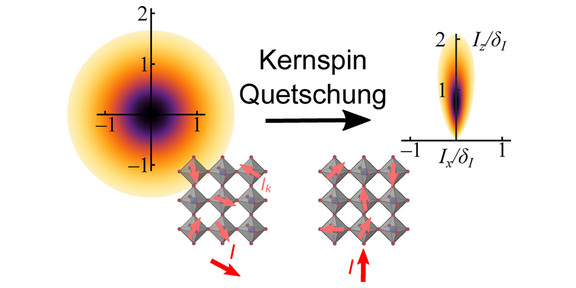International Research Team Observes Squeezing of a Dark Nuclear Spin State for the First Time
- Particle Physics
- Top News
- Research

First the researchers chemically synthesized a suitable crystal from the perovskite group, namely formamidinium lead tribromide. Then polarized light pulses were used to orient the spins of positively charged charge carriers in this crystal. When the positive charge carriers come into contact with lead nuclei in the crystal, they transfer their spin to the nuclear spins of the lead atoms. A collective nuclear spin state arises through this interaction. After that the nuclear spins involved – at least 35 of them – no longer act independently of one another, as a detailed analysis shows, but rather are linked together. The mutual dependence of the nuclear spins is referred to in quantum mechanics as entanglement.
State may be usable for quantum technologies
In the experiment, the interaction altered the orientation of the nuclear spins of the lead atoms in a very specific way. While before illumination with laser light their orientation was disordered – as characterized by the quantum-mechanical uncertainty principle – after sufficient illumination the nuclear spins oriented themselves preferentially along the direction of the optical illumination by the laser. In addition, the orientation of the nuclear spins fluctuated significantly less – not only in this longitudinal direction, but also transversely, perpendicular to the direction of illumination. Such a reduction of fluctuations in a quantum-mechanical state is called squeezing. The research team was able to observe the squeezing of such a collective nuclear spin state for the first time.
Through squeezing, the predicted dark nuclear spin state was achieved, which is insensitive to further optical excitation. Because of the resulting robustness, such a state could be used to store information quantum-mechanically – an important prerequisite for many quantum technologies, such as a quantum computer.
Contact for further questions:





![[Translate to English:] Partner Four hands are holding the green logo of TU Dortmund University](/storages/tu_website/_processed_/1/d/csm_Partner_Nicole_Rechmann_KW_670eba0154.jpg)




![[Translate to English:] Forschung An apparatus with tubes in a laboratory](/storages/tu_website/_processed_/0/c/csm_Forschung_Juergen_Huhn_4fa3153b51.jpg)
![[Translate to English:] Studium Five students are sitting in a lecture hall. They are talking to each other.](/storages/tu_website/_processed_/c/9/csm_Studium_FelixSchmale_dbdbfb0dd7.jpg)





